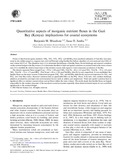Quantitative aspects of inorganic nutrient fluxes in the Gazi Bay (Kenya): implications for coastal ecosystems

View/
Date
2002-11Author
Mwashote, Benjamin M
Jumba Isaac O.
Type
ArticleLanguage
enMetadata
Show full item recordAbstract
Fluxes of dissolved inorganic nutrients: NHþ 4 , NO_ 2 , NO_3 , PO3_4 and Si(OH)4 from nearshore sediments of Gazi Bay were measured in situ within mangrove, seagrass and coral reef biotopes using benthic flux bell-jar chambers of cross-sectional area 0.066 m2 and volume 0.0132 m3. The objectives were: (1) to determine the influence of benthic fluxes, fluvial discharge and seasonal variations on the nutrient budget in the Bay waters; (2) to determine the effect of tidal and spatial variations on nutrient loads in the water column and (3) to establish the relative importance of the nutrient sources with regard to total community production of the Bay.
The directly measured fluxes ranged from _270 to þ148 lmol NHþ4 –N/m2/h; _60 to þ63 lmol NO_2–N/m2/h; _79 to þ41 lmol NO_3 –N/m2/h; _79 to þ75 lmol PO3_4 –P/m2/h and þ30 to þ350 lmol Si(OH)4–Si/m2/h for and respectively. It was established that benthic fluxes are the major sources of dissolved inorganic NHþ4 , NO_2 and Si(OH)4 while fluvial sources are important for NO_3 and PO3_4 into Gazi Bay waters. Seasonal variations had an appreciable effect on the PO3_4 fluxes, N: Si ratio, river nutrient discharge, plankton productivity and important environmental factors such as salinity and temperature. Tidal and spatial variations had no significant effect on nutrient concentrations and net fluxes within the water column. The results imply that benthic fluxes are largely responsible for the nutrient dynamics of the nearshore coastal ecosystems especially where direct terrestrial inputs do not contribute significantly to the nutrient budget.
URI
http://www.sciencedirect.com/science/article/pii/S0025326X02001765http://erepository.uonbi.ac.ke:8080/xmlui/handle/123456789/38227
http://www.ncbi.nlm.nih.gov/pubmed/12523518
Citation
Marine Pollution Bulletin Volume 44, Issue 11, November 2002, Pages 1194–1205Publisher
Department of Chemisty, University of Nairobi
Description
Full Text
